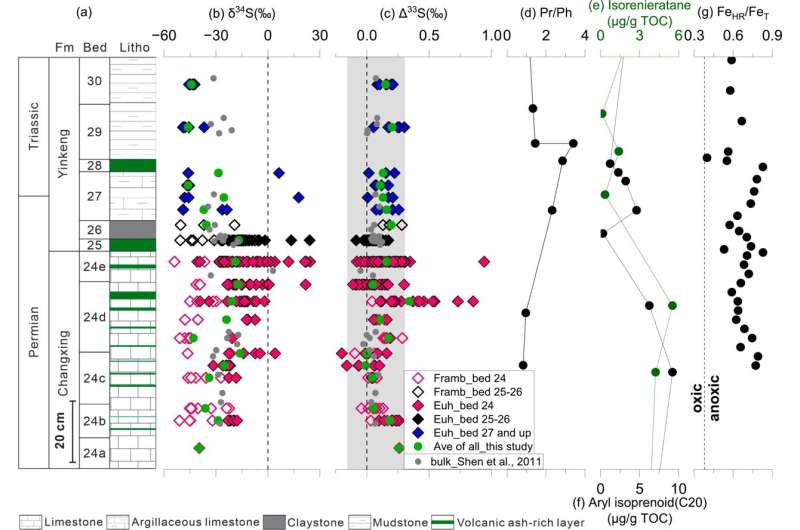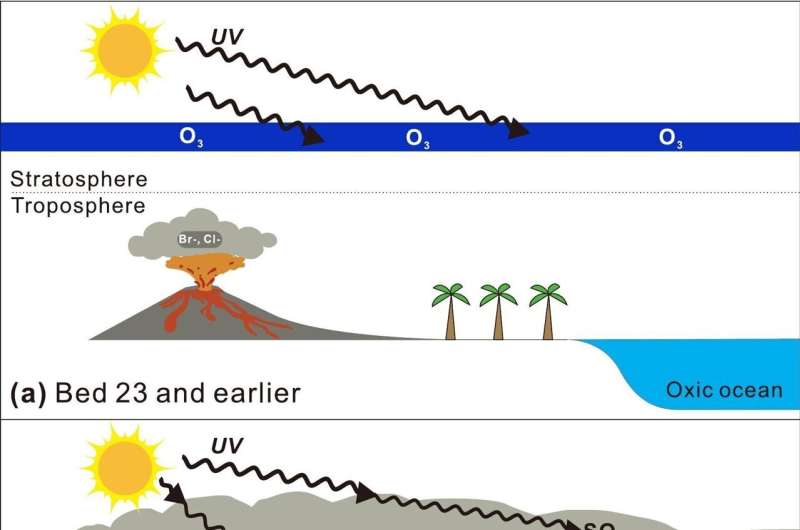February 12, 2024 feature
This article has been reviewed according to Science X's editorial process and policies. Editors have highlighted the following attributes while ensuring the content's credibility:
fact-checked
peer-reviewed publication
trusted source
proofread
Volcanism-induced ozone depletion may have contributed to Permian mass extinction, study finds

The concept of deadly mass extinctions wreaking destruction upon Earth's ecosystems millions of years ago is something that has fascinated the public and scientists alike for decades.
A groundbreaking publication by Jack Sepkoski and David Raup in 1982 identified the "Big Five" extinction events through the planet's geological history, these being defined as end-Ordovician (~444–445 million years ago, Ma), Late Devonian (~359–372 Ma), end-Permian (~252 Ma), end-Triassic (~201 Ma) and end-Cretaceous (~66 Ma). The end-Permian event is considered to be the largest of these biotic crises.
During this catastrophe, it is estimated that ~81% of all marine species and ~70% of terrestrial vertebrate species became extinct. But it was not only animals impacted by the event, as land plants also experienced significant mutations and destruction.
Explosive volcanism in the Siberian Large Igneous Province, covering an estimated 7,000,000 km2, is evidenced by massive pyroclastic flow deposits and postulated to be the most likely trigger for the end-Permian mass extinction. This caused a wide range of damaging effects, such as ocean anoxia, hydrogen sulfide poisoning, acid rain, ozone depletion and global warming.
New research published in Chemical Geology has investigated the link between volcanism damaging the ozone layer and enhanced irradiation of Earth, consequently leading to a plethora of irreversible change across the planet.
Dr. Rucao Li, postdoctoral researcher at Nanjing University, China, and colleagues studied pyrite from ash layers in the Meishan section, South China, to measure sulfur isotopes and understand the effect sulfur dioxide emissions from volcanoes had on stratospheric ozone.

To do so, the research team used secondary ion mass spectrometry to detect the presence of three sulfur isotopes (sulfur-33, sulfur-34 and sulfur-36) in microscopic pyrite grains (10–30 μm).
The scientists identified a distinct positive change of +0.30 ‰ to +0.94 ‰ in Mass-Independent Fractionation sulfur isotopes (MIF-S) in a bed of the study section located a few centimeters below the designated end-Permian bed, where there is a coincident increase in the abundance of ash layers. However, in the bed designated the Global Stratotype Section and Point (GSSP) of the Permian-Triassic Boundary, there is no distinct MIF-S signal.
Dr. Li and colleagues note that such a significant change has rarely been found in rocks younger than 2 billion years old due to the progressive increase in the planet's oxygen budget and ozone formation through time, which ultimately impacted the oxidation of sulfur.
The process by which volcanic emissions may have resulted in this planetary catastrophe relates to the photolysis (molecule breakdown due to the absorption of light) of sulfur dioxide by ultraviolet radiation.
Once explosive volcanism disrupted the ozone layer and entered the stratosphere there would have been fewer oxygen molecules blocking incoming solar ultraviolet radiation, resulting in the conversion of sulfur dioxide molecules to MIF-S sulfate aerosols, which were transported from land to the oceans. This has indeed been supported by modeling that suggested a decrease from 30% atmospheric oxygen in the Phanerozoic (beginning ~538 Ma) to half that by the end-Permian.
Dr. Li and colleagues suggest sulfate-reducing bacteria in the ocean then converted MIF-S-preserving molecules to hydrogen sulfide, making the marine realm both sulfidic and anoxic—a catastrophic combination for survival. With terrestrial organisms exposed to high-intensity ultraviolet radiation on land and oxygen-producers in the shallow photic zone of the sea negatively impacted, this would have filtered through the water column as oxygen supply declined. Ultimately, there was no escape on Earth from the damaging impacts of ozone destruction.
Though not at the same devastating scale, the concerns over ozone depletion in recent decades have very real consequences for our planet's terrestrial and marine organisms, as well as humans.
More information: Rucao Li et al, Atmospheric ozone destruction and the end-Permian crisis: Evidence from multiple sulfur isotopes, Chemical Geology (2024). DOI: 10.1016/j.chemgeo.2024.121936
Journal information: Chemical Geology
© 2024 Science X Network




















